Abstract
Rivers, lakes, oceans, volcanos, and forests are anthropomorphized by featuring them with humanlike facial characteristics or presenting a personified message. Whereas prior communications research has focused on comparisons between anthropomorphism and nonanthropomorphism, the current study proposes two types of anthropomorphism based on anthropomorphic valence: positive versus negative. Results of three experiments show that negative anthropomorphism is more persuasive for a sudden disaster but that positive anthropomorphism is more effective for an ongoing tragedy. Connectedness to nature is found as the underlying mechanism. Marketers should carefully frame the acuteness level of an environmental issue to complement the type of anthropomorphic valence in their advertisement.
- Received December 1, 2021.
- Received (in revised form) August 2, 2022.
- Accepted August 5, 2022.
- Copyright © 2022 ARF. All rights reserved.
ARF MEMBERS
If you are a member of the Advertising Research Foundation, you can access the content by logging in here
Log In
Pay Per Article - You may access this article (from the computer you are currently using) for 30 days for US$20.00
Regain Access - You can regain access to a recent Pay per Article purchase if your access period has not yet expired.





